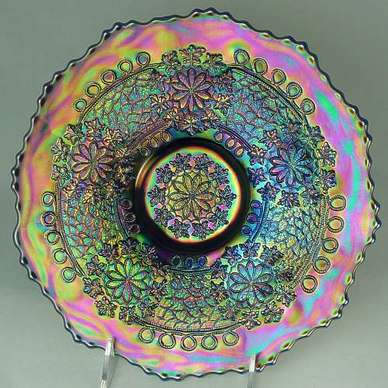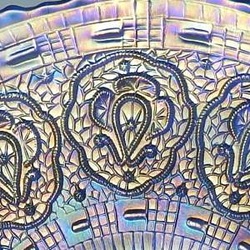Carnival Patterns inspired by Embroidery and Needlecraft
|
The "Newest Designs" heading appeared in a Los Angeles newspaper in 1906. The beautiful lettering was drawn to imitate embroidery stitching, and referred to the latest embroidery and needlework designs for household linens.
Imagine how it was before we had TV and the internet … no emails, no Facebook, no Candy Crush or eBay to distract you. What did people do? For women, needlework was often a favourite pastime – it was creative and enjoyable as well as being thrifty. Crochet, lacework, embroidery, quilting and more: newspapers and magazines such as the Home Needlework Magazine shown above, offered free patterns and guides. Shops had entire departments given over to needlecraft supplies. The ad shown on the right was in the Washington Herald (USA), but it also appeared in many other local newspapers – it was clearly a popular offer. Lilian, Clara, Quindiara and Emily? Do any of these names ring a bell for you? Probably not – but if we added their last names you would know. Lilian Fenton (Frank’s wife), Clara Northwood, Quindiara Fenton (John’s wife from Millersburg) and Emily Dugan – yes, they were the wives of the Fenton brothers, and cousins Harry Northwood and Tom Dugan. When Carnival Glass first began, the need to capitalise on its astonishing popularity would have driven a frenzy of new design production. Ideas don’t come out of thin air, and the creativity behind Carnival Glass patterns is usually felt to have stemmed from the glass men. But ... could it be that the wives of the glass makers, and the wives of the mould makers, also provided some of the inspirations for many of the designs? The women would almost certainly have done some kind of needlework, and there would surely have been newspapers and journals, such as the Ladies Home Journal or the Home Needlework Magazine, lying around the house. It’s entirely likely that the inspiration behind many Carnival patterns was found in the needlework designs shown in the journals, designs that were actually being stitched by one of their wives. They would have been right there in their parlours, in front of their eyes. And even better, these patterns were popular and familiar with the housewife who would likely purchase the glass. Win - Win. |
The unique quality of glass, plastic when molten and able to be moulded in fine detail, that allows the intricacy of embroidery to be reproduced to such a lasting effect, but the skills of the mould maker and the vision of the designer cannot be under-estimated. The mould makers emulated detailed stitches in patterns that were cut in an iron mould or plunger, and the designers recognised that when the shimmering colours and light-catching qualities of iridescence were added, the overall effect is magnificent, allowing all the minute details to be appreciated.
In Part Two, we look at the range of Carnival patterns that were inspired by needlecraft and embroidery. There are a few clues in the pictures below, and some of them may surprise you!
In Part Three, we show some of Glen's amazing drawings of some of the popular Carnival Glass patterns that were inspired by needlecraft. The drawings show in fine detail, the skills of the Carnival Glass designers and mould makers.







